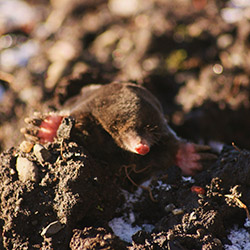 Mole
Mole
Mole Control, Trapping & Removal Services
We can rid you of Mole problems safely and efficiently
Have you ever looked outside your Dallas area home just to notice your well-manicured landscape has been ravaged by an unseen force? Is there a high number of unsightly mounds? This specific landscape damage is very likely due to moles burrowing tunnels just underneath ground level. Moles are most often found under your yard. They are always on the search for their preferred food sources: earthworms, grubs and other insects. Mole control will be necessary to return your landscape to normal.
While they hunt for food, moles dig extensive tunnels of up to 100 feet per day. They typically travel on their own, which makes control simpler than other animals, but these stubborn pests still involve extensive control.
Mole tunnels can be a frustrating and costly problem for homeowners all across the country. However, there is an easy remedy with the help of Trutech of Dallas’ mole removal experts. Ensure that these medium-sized mammals aren’t searching for food in your yard anymore by implementing Trutech’s Dallas mole control. Keep your Dallas yard in tip-top shape without sacrificing your time and energy!
Trutech’s humane mole traps and other ground mole removal services will effectively and safely resolve your problems. Regardless of whether you’re looking for mole control, mole trapping or mole-proofing services, you can feel confident that you’re using the safest mole control methods available on your Dallas yard.
What Attracts Moles to Yards?
Moles spend most of their time underground digging tunnels, and as such, they favor loose soils like gardens, woodlands and—unfortunately—your yard.
Moles are also drawn to your yard because of the available food sources. Their primary food source is earthworms, which are quite prominent in moist and well-manicured lawns. Moles also eat snails, grubs, spiders and sometimes even vegetation. Most of these insects and foliage are found on residential properties.
Mole Problems & Damage
Because they spend lots of time away from human sight, it’s easy for them to live on your lawn undetectable for a while.
Some pretty clear signs of moles in your yard are mounds of dirt (known as molehills), dug up plants and yellowed lawns, due to the pests’ disruption of root systems while digging. A ground mole in your yard can make lawn maintenance and gardening difficult, and can be costly for property owners by ruining costly landscaping.
Ground Mole Removal
Upon establishing an infestation, moles are hard to control. Many types of mole baits are available, but in order to properly keep them out of your yard, it’s vital that they are administered properly. Dallas homeowners often don’t have this knowledge and ability firsthand.
Because moles are notorious for coming back to yards once they settle, correct removal is imperative to preventing future issues. When dealing with moles in your Dallas yard, contact a professional company like Trutech of Dallas!
APPEARANCE
Some of the most distinguishing mole characteristics include their long, pointed snouts and broad forepaws. Though they appear to lack eyes, the organs are simply hidden in their fur and may even be covered with a thin membrane of skin. Moles are velvety gray to dark brown in color, and they generally grow about 6 inches long. Their large hands are slightly webbed and tipped with sharp claws that make them proficient diggers.
DIET
As insectivores, moles typically eat invertebrates found within the shallow layers of soil. Their diet commonly includes earthworms, grubs, beetle larvae, and ants. Moles eat 70 to 100 percent of their body weight every day in order to acquire enough energy to power their intense digging activities. Occasionally, they eat seeds for sustenance but rarely consume bulbs or tubers.
HABITAT
Cool, damp soil and areas of loosely packed dirt where worms and grubs can be found in abundance are preferred mole habitats. They are unable to live in hard, compacted soil or areas with dry, sandy dirt because these terrains are not suitable to digging and lack their favored foods. Their burrows consist of a series of interconnected deep and shallow tunnels, as well as comfortable dens lined with plant matter.


